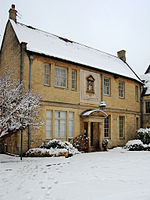Church of St Peter-le-Bailey
1122 establishments in England19th-century Church of England church buildingsChapels of the University of OxfordChurch of England church buildings in OxfordChurches completed in 1874 ... and 1 more
St Peter's College, Oxford

The Church of St Peter-le-Bailey is a church on New Inn Hall Street in central Oxford, England. It was formerly next to Bonn Square, which was originally the churchyard. Now it is located halfway up New Inn Hall Street to the north. Several churches have existed on or close to the site. The current church is now the chapel of St Peter's College, Oxford.
Excerpt from the Wikipedia article Church of St Peter-le-Bailey (License: CC BY-SA 3.0, Authors, Images).Church of St Peter-le-Bailey
New Inn Hall Street, Oxford City Centre
Geographical coordinates (GPS) Address Website External links Nearby Places Show on map
Geographical coordinates (GPS)
| Latitude | Longitude |
|---|---|
| N 51.75253 ° | E -1.26061 ° |
Address
St Peter's Chapel
New Inn Hall Street
OX1 2DH Oxford, City Centre
England, United Kingdom
Open on Google Maps







